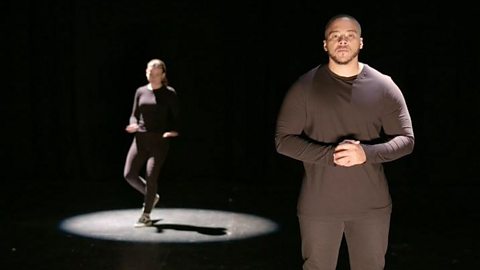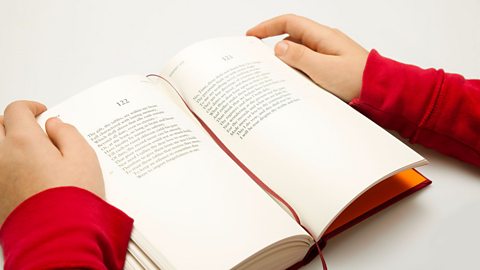When you are asked to talk about the structure of a poem it can seem a bit daunting, but there are lots of things you can comment on:
- the shape of the poem on the page
- the number and lengths of stanzas
- the number and lengths of lines
- the number of beats and rhythm of words in each line
- the pattern of rhymes, if any
- the use or non-use of punctuation
- whether the poem has a set form or not
Every poem has structural features that have a bearing on the way the poem sounds or what it means. To comment on the structure of a poem is just the same as commenting on its language ÔÇô you notice and describe a detail, then explain what effect you think the writer was trying to achieve for the audience by including that detail.
Poetic forms
The form, the physical structure of a poem, refers collectively to line lengths, rhythms and patterns of rhyme. It includes both how the poem looks on the page and how it sounds when read out loud. There are some forms of poetry which follow specific rules and others which can be more free.
The stanzaStanzas separate poems into groups of lines. in a poem are like paragraphs in prose. They separate ideas and give shape, and guide the reader through the poem.
Find out how to identify form in poetry
Open and closed form
Open form is very free - it doesnÔÇÖt have to follow traditional or specific patterns. This style of poetry may not follow any rules at all or it might use small elements of traditional forms of poetry. When looking at an open form poem consider some of the structural ideas, such as rhyme and the rhythm, and think about how these have been created and why.
John AgardÔÇÖs Checking Out Me History is an example of an open form poem but one that still has a shape and structure. It is divided into stanzas - poetic paragraphs - and includes some rhyme and rhythm but not in a regular pattern. If we look at the opening stanza we can see this:
Dem tell me
Dem tell me
Wha dem want to tell me
Because this poem is criticising aspects of ÔÇ£traditionalÔÇØ education, the poet may have chosen an open structure with no set rules of rhyme or rhythm to compliment his use of ÔÇİpatoisÔÇÖ or dialect language, and to help show he wants to go beyond what is traditional. The form of the poem in this case helps link to what the poem is about.
Closed form is much more structured, and governed by specific rules, or patterns. In closed form poetry specific poetic structures may repeat throughout the poem, perhaps to create rhythmic effects.
Emily Dickinson has repeated some clear patterns in the poem A Bird, came down the Walk. Dickinson has divided the poem into five stanzas, where each one is four lines long and has a rhyme scheme where the second and fourth lines rhyme. Most lines have the same number of syllables, which helps create a recognisable rhythm.
A Bird, came down the Walk -
He did not know I saw -
He bit an Angle Worm in halves
And ate the fellow, raw,
Perhaps the tightly controlled form reflects the precise actions of the bird, and draws attention to the brutal behaviour of actually killing the worm. Dickinson, like Agard, chooses a form that helps link to the subject of the poem.
Understanding form
To understand the form of a poem you can start by looking at its shape. Ask yourself some of the following questions:
- Is the poem split into stanzas and if so how many?
- Are they the same length?
- Is there a rhyme scheme?
- Is there a clear rhythm, with a regular beat or number of syllables per line?
Shakespearean sonnets, for example, are 14 lines long and have a clear set structure. A Shakespearean sonnet follows the rhyme scheme ABAB CDCD EFEF GG.The lines form three quatrains, which are sets of four lines, and the sonnet ends with a closing rhyming couplet.
Try reading ShakespeareÔÇÖs Sonnet 18 aloud so you can hear how the rhyme scheme works:
Shall I compare thee to a summerÔÇÖs day?
Thou art more lovely and more temperate.
Rough winds do shake the darling buds of May,
And summerÔÇÖs lease hath all too short a date.
Sometime too hot the eye of heaven shines,
And often is his gold complexion dimmed;
And every fair from fair sometime declines,
By chance, or natureÔÇÖs changing course, untrimmed;
But thy eternal summer shall not fade,
Nor lose possession of that fair thou owÔÇÖst,
Nor shall death brag thou wandÔÇÖrest in his shade,
When in eternal lines to Time thou growÔÇÖst.
So long as men can breathe, or eyes can see,
So long lives this, and this gives life to thee.
Sonnets are a poetry form with a long and distinguished history, so most sonnets you will see and study are either from an historical period that considered the form important, or from a more recent writer who is trying to create a sense of seriousness and significance by choosing that traditional form for their poem.
There are other closed forms of poetry you may know already, such as limericks, which can be recognised by their number of lines, syllables per line and where their rhymes, if any, are.
A haiku is a short closed form of poetry that relies on a syllable pattern. It usually has five syllables in the first line, seven in the second, and five in the third and final line, as in this example by Kobayashi Issa:
Everything I touch
with tenderness, alas,
pricks like a bramble.
Although haiku is a closed form of poetry, haikus do not usually rhyme.
Test yourself
More on Understanding poetry
Find out more by working through a topic
- count1 of 4

- count2 of 4

- count3 of 4
